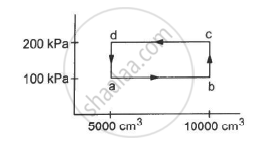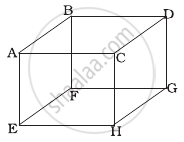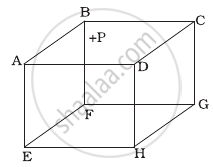Advertisements
Advertisements
प्रश्न
1 litre of an ideal gas (γ = 1.5) at 300 K is suddenly compressed to half its original volume. (a) Find the ratio of the final pressure to the initial pressure. (b) If the original pressure is 100 kPa, find the work done by the gas in the process. (c) What is the change in internal energy? (d) What is the final temperature? (e) The gas is now cooled to 300 K keeping its pressure constant. Calculate the work done during the process. (f) The gas is now expanded isothermally to achieve its original volume of 1 litre. Calculate the work done by the gas. (g) Calculate the total work done in the cycle.
उत्तर
Given:
γ = 1.5
T = 300 K
Initial volume of the gas, V1 = 1 L
Final volume, V2 = `1/2` L
(a) The process is adiabatic because volume is suddenly changed; so, no heat exchange is allowed.
P1V1γ = P2V2γ
Or `"P"_2 ="P"_1("V"_1/"V"_2)^gamma = "P"_1(2)^gamma`
`"P"_2/"P"_1 = 2^1.5 = 2 sqrt2`
(b) P1 = 100 kPa = 105 Pa
and P2 = `2sqrt2` × 105 Pa
Work done by an adiabatic process,
`"W" = ("P"_1"V"_1 - "P"_2"V"_2)/(gamma - 1)`
`"W" = (10^5 xx 10^-3 -2sqrt2 xx 10^5 xx 1/2 xx 10^-3)/(1.5 -1)`
W = -82 J
(c) Internal energy,
dQ = 0, as it is an adiabatic process.
⇒ dU = − dW = − (− 82 J) = 82 J
(d)
Also, for an adiabatic process,
T1V1γ−1 = T2V2γ−1
`"T"_2 ="T"_1 ("V"_1/"V"_2)^(gamma -1)`
= 300 × (2)0.5
`= 300 xx sqrt 2 xx = 300 xx 1..4142`
T2= 424 K
(e) The pressure is kept constant.
The process is isobaric; so, work done = PΔV=nRdT.
Here, n = `("P""V")/("R""T") = (10^5 xx 10 ^-3)/("R" xx 300) = 1/(3"R")`
So, work done =`1/(3"R") xx "R" xx (300-424) = -41.4"J"`
As pressure is constant,
`"V"_1/"T"_1 = "V"_2/"T"_2 ... (1)`
`"V" _1 = "V"_2("T"_1)/"T"_2`
(f)Work done in an isothermal process,
`"W" = "n""R""T" "l""n" "V"_2/"V"_1`
= `1/(3"R") xx "R" xx "T" xx ln (2)`
= 100 × ln 2 = 100 × 1.039
= 103 J
(g) Net work done (using first law of thermodynamics)
= − 82 − 41.4 + 103
= − 20.4 J
APPEARS IN
संबंधित प्रश्न
Keeping the number of moles, volume and temperature the same, which of the following are the same for all ideal gases?
Consider the quantity \[\frac{MkT}{pV}\] of an ideal gas where M is the mass of the gas. It depends on the
Calculate the volume of 1 mole of an ideal gas at STP.
Find the number of molecules in 1 cm3 of an ideal gas at 0°C and at a pressure of 10−5mm of mercury.
Use R = 8.31 J K-1 mol-1
Let Q and W denote the amount of heat given to an ideal gas and the work done by it in an isothermal process.
A rigid container of negligible heat capacity contains one mole of an ideal gas. The temperature of the gas increases by 1° C if 3.0 cal of heat is added to it. The gas may be
(a) helium
(b) argon
(c) oxygen
(d) carbon dioxide
Half mole of an ideal gas (γ = 5/3) is taken through the cycle abcda, as shown in the figure. Take `"R" = 25/3"J""K"^-1 "mol"^-1 `. (a) Find the temperature of the gas in the states a, b, c and d. (b) Find the amount of heat supplied in the processes ab and bc. (c) Find the amount of heat liberated in the processes cd and da.

An ideal gas (γ = 1.67) is taken through the process abc shown in the figure. The temperature at point a is 300 K. Calculate (a) the temperatures at b and c (b) the work done in the process (c) the amount of heat supplied in the path ab and in the path bcand (d) the change in the internal energy of the gas in the process.

The volume of an ideal gas (γ = 1.5) is changed adiabatically from 4.00 litres to 3.00 litres. Find the ratio of (a) the final pressure to the initial pressure and (b) the final temperature to the initial temperature.
An ideal gas at pressure 2.5 × 105 Pa and temperature 300 K occupies 100 cc. It is adiabatically compressed to half its original volume. Calculate (a) the final pressure (b) the final temperature and (c) the work done by the gas in the process. Take γ = 1.5
Two samples A and B, of the same gas have equal volumes and pressures. The gas in sample A is expanded isothermally to double its volume and the gas in B is expanded adiabatically to double its volume. If the work done by the gas is the same for the two cases, show that γ satisfies the equation 1 − 21−γ = (γ − 1) ln2.
Figure shows a cylindrical tube with adiabatic walls and fitted with an adiabatic separator. The separator can be slid into the tube by an external mechanism. An ideal gas (γ = 1.5) is injected in the two sides at equal pressures and temperatures. The separator remains in equilibrium at the middle. It is now slid to a position where it divides the tube in the ratio 1 : 3. Find the ratio of the temperatures in the two parts of the vessel.

Two vessels A and B of equal volume V0 are connected by a narrow tube that can be closed by a valve. The vessels are fitted with pistons that can be moved to change the volumes. Initially, the valve is open and the vessels contain an ideal gas (Cp/Cv = γ) at atmospheric pressure p0 and atmospheric temperature T0. The walls of vessel A are diathermic and those of B are adiabatic. The valve is now closed and the pistons are slowly pulled out to increase the volumes of the vessels to double the original value. (a) Find the temperatures and pressures in the two vessels. (b) The valve is now opened for sufficient time so that the gases acquire a common temperature and pressure. Find the new values of the temperature and pressure.
An ideal gas of density 1.7 × 10−3 g cm−3 at a pressure of 1.5 × 105 Pa is filled in a Kundt's tube. When the gas is resonated at a frequency of 3.0 kHz, nodes are formed at a separation of 6.0 cm. Calculate the molar heat capacities Cp and Cv of the gas.
1 mole of an ideal gas is contained in a cubical volume V, ABCDEFGH at 300 K (Figure). One face of the cube (EFGH) is made up of a material which totally absorbs any gas molecule incident on it. At any given time ______.

ABCDEFGH is a hollow cube made of an insulator (Figure). Face ABCD has positive charge on it. Inside the cube, we have ionized hydrogen. The usual kinetic theory expression for pressure ______.

- will be valid.
- will not be valid since the ions would experience forces other than due to collisions with the walls.
- will not be valid since collisions with walls would not be elastic.
- will not be valid because isotropy is lost.
In a diatomic molecule, the rotational energy at a given temperature ______.
- obeys Maxwell’s distribution.
- have the same value for all molecules.
- equals the translational kinetic energy for each molecule.
- is (2/3)rd the translational kinetic energy for each molecule.
We have 0.5 g of hydrogen gas in a cubic chamber of size 3 cm kept at NTP. The gas in the chamber is compressed keeping the temperature constant till a final pressure of 100 atm. Is one justified in assuming the ideal gas law, in the final state?
(Hydrogen molecules can be consider as spheres of radius 1 Å).
